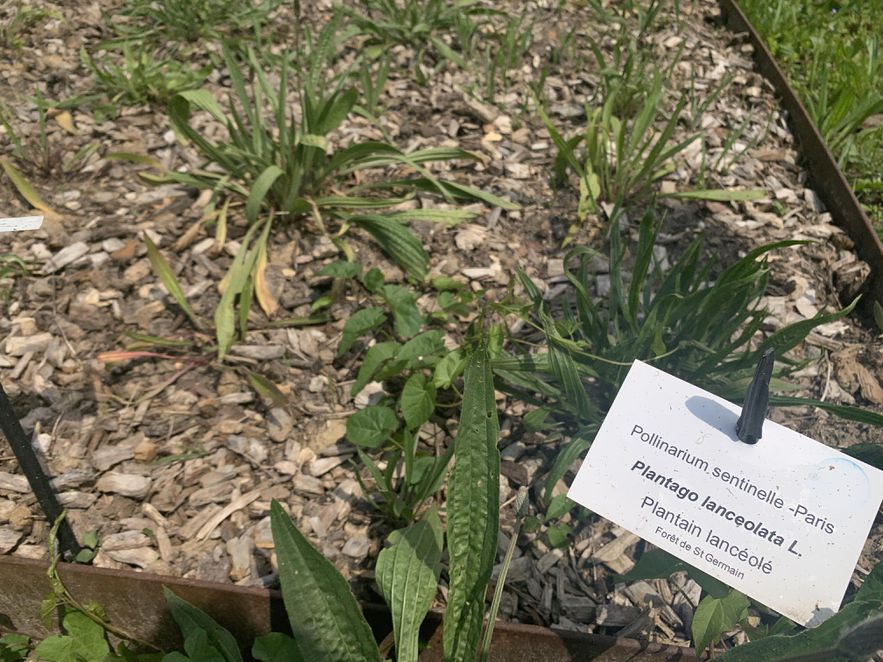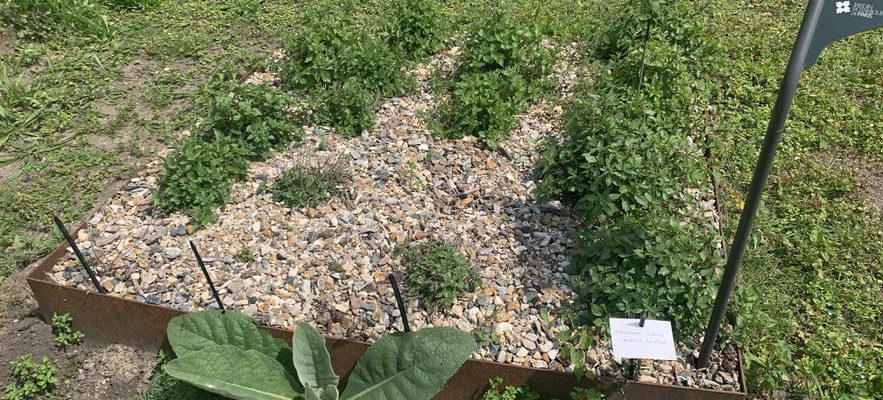At the Parc Floral in Paris, it is difficult to see it. After a little research, he finally discovered himself. A few herbaceous squares, about thirty pots where birches, ash trees, plane trees grow and here is the pollinarium sentinel. Here, the most allergenic plants and trees in Île-de-France are concentrated on a small area in order to detect the first emissions of pollen from each plant as early as possible.
Thanks to these daily observations made by municipal gardeners, health professionals and allergy sufferers registered in the newsletter of theassociation of sentinel pollinariums of France (APSF) are quickly notified when a plant begins or ends its pollen emission.
Here is a herbaceous patch of the Paris pollinarium. Here, plants from the four corners of the Ile-de-France region are brought, to guarantee the greatest genetic diversity. L’Express/IPJ/Fleur Tirloy
© / L’Express/IPJ/Fleur Tirloy
A newcomer, the Paris sentinel pollinarium was inaugurated at the start of 2023, after a year of testing. It joins the twenty pollinariums already present in France, and the ten under construction.
A concrete way to raise awareness of allergies, while one in ten French people suffer from pollen allergies, compared to 1% in 1960. The phenomenon is exploding and the forecasts are worrying, the World Health Organization (WHO) estimates Moreover, 50% of the world’s population will be affected by this immune disorder by 2050.
In question, global warming and pollution which increase the duration of the pollen seasons, increase the amount of pollen in the air and aggravate our sensitivity to these allergens. “Atmospheric pollution weakens the grains which break and become smaller. They are then more irritating because they penetrate our bronchi more easily”, specifies Julia Maguéro.
Picked up from all over town
Faced with this growing public health challenge, the city of Nantes was the first to take action by creating the first pollinarium in France in 2012. A concept tested for nearly ten years, the time needed to set up a scientific protocol.
Thus, at the time of the creation of a pollinarium, the gardeners recover for a single species five plants coming from the four cardinal points, within a radius of 40 kilometres. A measure that guarantees greater genetic diversity.
“The most important thing is to have maximum sunshine and shelter from the wind. This allows the plants best exposed in nature to develop normally. Each year, we realize that genetic and exposure differences modify the beginning of flowering within the same species”, explains Julia Maguéro, in charge of partnerships and communication within the APSF.
Proven effectiveness?
A protocol that questions: “I doubt its effectiveness. When you take a plant west of a city, and bring it 40 kilometers away, it may not In addition to this, the rooting of trees is limited by the pots, and certain species present around the herbaceous squares risk, by pollinating, spreading their pollen to the species of the pollinarium, and therefore distorting the results. “, explains a botanist based in Brittany over the phone.
In Laval, in Mayenne, a sentinel pollinarium, the second in France, has been installed since 2013. For the gardener in charge of its maintenance, this control zone is representative of the behavior of plants in their natural environment, although some adaptations were necessary. .
“On certain plants, and in particular on corylus (Editor’s note: hazel) we see that they emit a little faster in nature. For two years, we have been authorized to take into account the first emissions from hazel trees which are found in nature, and not those of the pollinarium. This allows us to advance the alert for allergists”, explains the municipal gardener.

The Paris pollinarium brings together species from Île-de-France. At the beginning of each pollen emission, the gardeners notify the APSF, which distributes the information through its newsletter. L’Express/IPJ/Fleur Tirloy
© / Fleur Tirloy
A discrepancy which, according to him, does not detract from the coherence of this system: “With ten years of hindsight, I can only think of it well. This system allows us to think outside the box and get in touch with the medical world. You feel more useful,” he says.
A feeling shared by Hervé Tiger, the gardener in charge of the Rennes pollinarium since its creation in 2016. “It’s a real help for allergists and allergy sufferers who are better informed about the precise moment when to start their treatment”, argues he. According to him, it is also a good detection tool, which complements the pollen sensors present in large cities.
The eye, the only sensor in pollinariums
“The sensors have a quantitative aim, whereas the pollinariums aim to detect the very first emissions, almost in real time”, continues Julia Maguéro. A multi-partner project which associates the city in its capacity as manager, the regional health agency which participates in its financing for a total cost estimated between 4,000 and 6,000 euros, and the APSF.
The installation of pollinariums in around thirty French cities would therefore allow public policies to rethink their green spaces, avoiding the planting of certain species, such as birches. “Today, we recommend that cities systematically associate an allergist doctor who knows the allergenic species in the region with development plans,” continues the APSF member. Sensitize some, to desensitize others.
Entrepreneurs, comedians, conductors, roofers or even influencers, they are active in the fight against climate change. For L’Express, students from the Institut Pratique du journalisme Paris Dauphine set out to meet small and large players in climate action in France.
